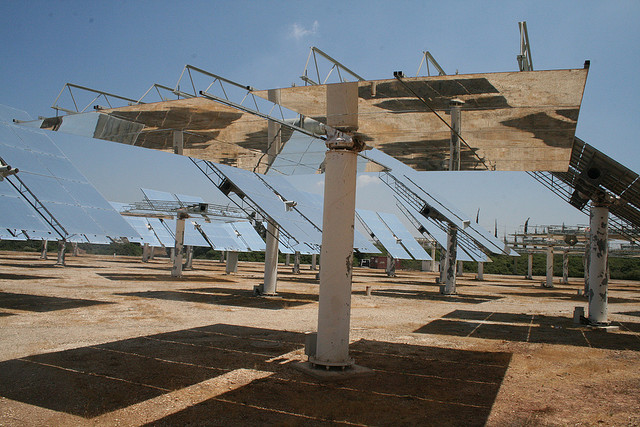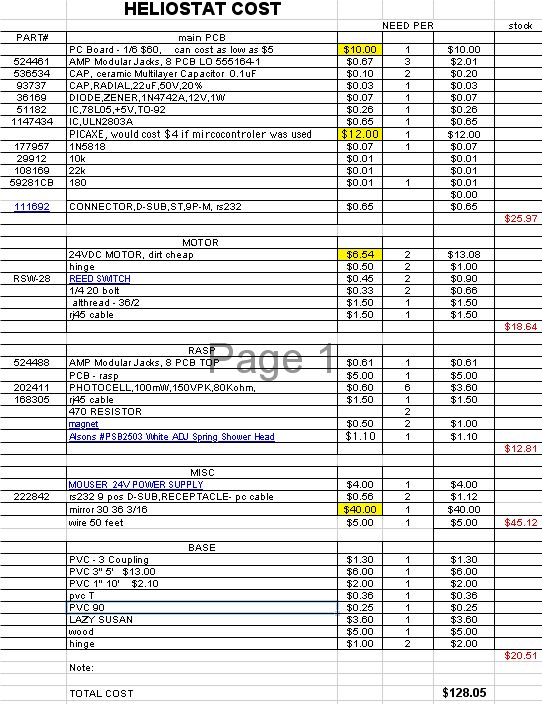Heliostat
(... could somebody please write an explainer text about heliostats ?; it goes here ....)
- sun-tracking mirrors
- focuses sunlight on one spot
Heliostats by Leo Gerst at Heliostat.us
Leo Gerst (link: Heliostat.us) has built heliostat prototypes that cost $130 per square meter total for a 2-axis tracking heliostat - using off-shelf parts. This is a breakthrough price achievement, and indicates potential economic feasibility of concentrator solar thermal power using heliostats on a small scale. For example, 30 such mirrors, at $4k - at 30 kW of energy focused on a square meter - could realistically power a heat engine. The detailed price list is:
Download the Excel spreadsheet for some sourcing links here.
Conversation of Leo Gerst with Marcin
- See heliostat prototypes from Leo (leogerst at hotmail dot com):
http://www.heliostat.us/howitworks.htm
- Within 150 feet, 2.5 feet up and 6 foot wide.
- Home Depot mirror - 36x32" mirror - ended up being 5' wide for an image 115 feet - left to right was 4 feet, 1 foot high image, $40 at Home Depot
- Flat mirror is less expensive
- Motors for 8 dollars, so $16 per mirror. PIC, $12 - bootloader on processor, $3 for PIC itself, but $12 with program
- $1.20 for all-thread
- $150 controller - but go with OS
- Proof of concept: gather energy effectively. Make a hotspot.
- 1 ton turbine - 1 ton of water per hour
- $100 per panel
- Probably discount at 1000 glass pieces
- Pole in front in picture is the detector
- Photo sensors are $1 each, key to the project
- Shower head screws into PVC
Conversation of Leo Gerst with Alex Hornstein
Forwarded message ----------
From: Alex Hornstein <alex#at#nublabs#dot#com> Date: Fri, Aug 8, 2008 at 4:23 PM Subject: Re: Heliostat Thesis To: Leo Gerst <leogerst#at#gmail#dot#com>
hey Leo,
My (undergrad and only) thesis was actually on designing and building a handheld oscilloscope. I've been working for the past three or four years on heliostats and solar stuff in general, but I don't have any academic papers for you.
I like what you've done, and it looks pretty advanced. Nobody's ever beat a cost of $250 for a square meter of built, installed and actuated heliostat, and it's exciting that your cost is so low. Looking at your youtube video of your mirrors moving, I really appreciate your sensing solution--that's very smart and effective. I think your biggest problem right now is of accuracy. Looking at the step size of your mirrors as they move, it looks like their accuracy is worse than .5 degrees, and the maximum theoretical concentration a field of heliostats is limited by your angular error (as well as the optics of your receiver). I'd work on improving that.
Arduino-Based Heliostat Controller
From Daan van Geijlswijk, daan #at# zininzelfdoen.nl, who is working on an open source heliostat system: http://zininzelfdoen.ning.com/
Work by Gabriel Miller at Cerebral Meltdown
Heliostats are generally used for solar energy. Although not as popular as solar panels, they can potentially give you access to considerable amounts of untapped heat energy for a much lower price, assuming, of course, you build it yourself.
Work by Brendan from heliostats.org
Brendan from Heliostats.org has been making some progress with his heliostat project. The gears you see in the above picture were printed out with his Makerbot. Pretty neat idea. A printable heliostat for solar power. The future looks very cool indeed.
Work by Mark
Here is a heliostat which was sent in by Mark. He says that he has had it up and running for about a year now without having to make any recalibrations. It looks pretty cool. He has several more projects on his site besides just this one, so don't forget to check them out too. More information at Heliostaat.nl (in Dutch).
Work by Rob at IwillTry.org
Elsewhere on the OSE Wiki
Possible heliostat applications in the OSE context
- lighting and space heating for buildings
- enhanced lighting and heating of greenhouses
- water heating for various applications; examples: aquaponics (see Tilapia aquaculture), steam for wide variety of uses (sterilizing and cleaning things, process heat, etc.)
- biomass drying, even solar torrefaction (examples of wet biomass: biogas slurry, manure, humanure, duckweed, wood etc.)
- extreme solar concentration for metallurgy (requires something like a Fresnel lens, ideally of glass)
- distillation of alcohol and other fuels
- to power an open source modern steam engine
- solar pyrolysis system for biochar production (unproven idea, no designs exist)

